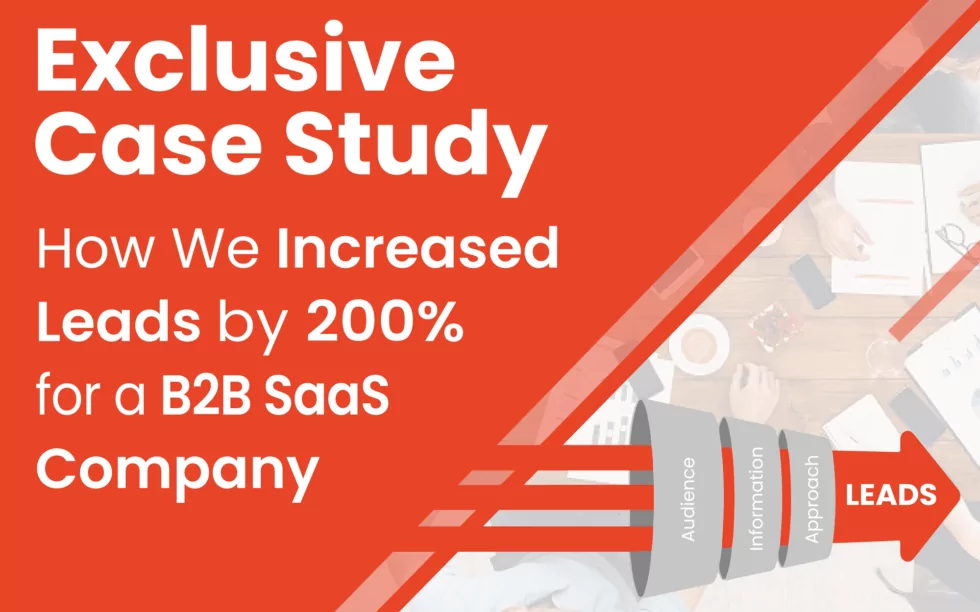B2B Lead Generation Strategy: How We Increased Leads By 200% For A SaaS Company

Most likely, the reason you are here is because you have encountered a bottleneck. A certain lead generation strategy was working perfectly fine for your company… until it didn’t. Maybe referrals have stopped, fairs are cancelled, social ads aren’t delivering anymore or there simply aren’t enough leads in the pipeline. All of your lead sources seem to have dried up.
So to stimulate your business, you need an organic (adless) lead generation channel. Below you’ll find a strategy that worked wonders for one of our B2B clients.
Step by step, we’ll walk you through the process on how we increased their leads by no less than 200%. We also managed to schedule an extra demo call each day. And to top it off: this all happened in only a few days time!
Now before we get into the details of tactics, let’s briefly define the brand and its challenges first.
The brand
- Creates logistic software for companies
- Previous strongest marketing channel: word-of-mouth
- Pain point: manual outreach process → time and labor-intensive
The brand’s needs
- Increase sales leads
- Schedule meetings automatically in sales reps’ agendas
- Generate extra income from new clients
We came up with a strategy that included:
- Finding your target audience (prospecting)
- Preparing a lead list
- Creating an outreach strategy
- Writing nurture emails
- Automating the process
- Integrating different marketing tools
How exactly did we achieve this, you ask? Dive into the details with us!
Four steps to get hundreds of quivering quality leads
Step 1: finding your audience
LinkedIn Sales Navigator is by far the best tool to pinpoint audiences for B2B companies. Most business owners are on LinkedIn, so with over 25 filter options, LinkedIn Sales Navigator can definitely help you find the right decision-makers.
Of course you have to know how to use it properly. Through a brainstorm with the client, we defined the persona, created a LinkedIn segmentation, and found over 300 highly qualified decision-makers.
Step 2: extracting the outreach information
We have put together a list of decision-makers. Now the difference between a good list and a great one lies within the level of personalization. The more personally you target, the more likely people reply to your campaign.
In this next step, we insert marketing tools to extract information from the LinkedIn database. By using smart marketing tools such as Phantombuster or Dux-soup, we extracted the information from thousands of leads in only a few minutes. Once you get to their LinkedIn information, it becomes very easy to find their GDPR-friendly business email addresses. This way you can quickly compile a qualitative list.
Step 3: creating an irresistible approach
Marketers generally boo cold emailing. Truth be told, instead of collaborating with a copywriter to create a value-driven approach, people are often creating spammy, salesy and sloppy cold emailing campaigns. And those are obviously not working.
And yet we don’t boo cold emailing! Why? We believe that if you master this art, it remains one of the most efficient and effective marketing channels.
Discover how we got a 65% open and 50% reply rate on 311 super-targeted emails
Step 1: LinkedIn Operation
Since we know our prospects can be found on LinkedIn, we always send them connection requests including warm messages, automated and safe.
Next, you will find the different acceptance rates of two completely different connection messages, aka A/B testing.


The connection request really is the game-changer of our campaign. This provides us with an actual touchpoint with our prospects, we aren’t just messaging them out of the blue. They get to see what we share on LinkedIn and we get to like or comment on their posts.
We’re in!
Step 2: Drip email strategy – consequent emails
In the following step, we’re writing personalized emails to approach our prospects. Read on to learn how to create a successful cold emailing campaign.
For this specific campaign, our conversion copywriter composed four emails. Value-driven strategies, subject lines, and of course words are carefully selected.
Above that, we always make sure not to sell anything without cultivating a relationship first. A straightforward approach: giving some value yourself first to then seize some. This gesture can be an eBook, webinar invite, use-cases, anything really.
So once you finish the first email, you then write at least two follow-ups for the receivers who haven’t responded yet.

After the emails, the right tools, automation, and integration will autonomize the process.
Step 4: marketing automation and integration
Following questions may arise:
- Are these emails being sent manually?
- What do we do when someone answers an email?
- How can we track the process and reply to their emails?
- Is it possible to integrate all these interactions into our CRM system?
To make this process seamless, we use the most advanced marketing tools and integrations.
For this campaign, our tools stack respectively consisted of Phantombuster, Lemlist, Zapier, and their CRM system. We connected all these. The only thing our clients had to do was just show up in the generated meetings. Here are the results.

Besides the 200% increase in lead generation, the client now also has a lead generation blueprint, which he can repeat to other target segments over and over again. All he has to do is find another highly targeted audience, replay the strategy, and reap the conversion results again.
Here we conclude this specific case for this B2B client of ours. Of course, every case is different, so we change our approach and create separate strategies each time. We deliver results in weeks!
